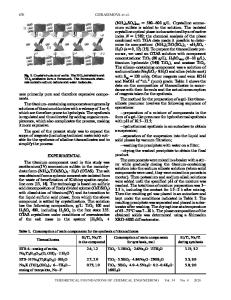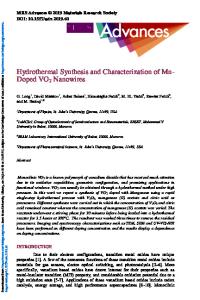Synthesis and Characterization of Zeolites for Anti-corrosion Application: The Effect of Precursor and Hydrothermal Trea
- PDF / 1,981,043 Bytes
- 10 Pages / 593.972 x 792 pts Page_size
- 5 Downloads / 346 Views
JMEPEG https://doi.org/10.1007/s11665-018-3602-5
Synthesis and Characterization of Zeolites for Anti-corrosion Application: The Effect of Precursor and Hydrothermal Treatment L. Rassouli, R. Naderi, M. Mahdavian, and A.M. Arabi (Submitted April 6, 2018; in revised form July 22, 2018) Four different hydrothermal processes were used to synthesize NaX zeolites. The effect of the precursor, hydrothermal time and temperature on the zeolite structure was investigated in this research. The results of XRD and FESEM/EDX analysis indicated the key role of aluminum sources in the amorphous content and the structure of zeolite from non-zeolite sodium aluminum silicate hydrate to favorable NaX-faujasite. Moreover, the irregular shape of agglomerated hydrogel was changed from micro- to nano-zeolite structure via the hydrothermal process of different aluminum sources. It was found that the nano-zeolites could be formed by sodium aluminate source. In addition, the synthesized zeolite particles were examined as corrosion inhibitor reservoir, considering the effect of Si/Al ratio, particle size, and amorphous content. It was shown that there is a direct relation between crystallization and ion exchange capacity. Through monitoring the behavior of bare mild steel in sodium chloride solution containing zinc cations released from the zeolite particles, it was found that the nano-zeolite particles with low Si/Al ratio can offer the most effective corrosion inhibition. Keywords
corrosion inhibition, hydrothermal synthesis, ion exchange capacity, NaX zeolite
1. Introduction Zeolite, as one of the most important minerals, has the crystalline aluminosilicate or silicate structure in which SiO4 and AlO4 tetrahedral are arranged by a three-dimensional network (Ref 1, 2). Cage-like structure with a highly regular and open microporous is the advantage of this structure (Ref 35). The faujasite-type zeolites are categorized into NaX and NaY based on Si/Al ratio. The ratio, determining cation sites, is more than 2 in NaY zeolites and close to 1 in NaX zeolites (Ref 6-8). Although the zeolites have been commonly used as catalysts in petroleum and petrochemical industry, nowadays they are developed as ion exchangers and sieves in agriculture, detergent manufacturing, and wastewater treatment (Ref 1, 9, 10). The ion exchange capability of the materials has arisen from the isomorphous substitution of alumina on silicate, resulting in a surface with a negative charge. Accordingly, cations are affiliated to neutralize the surface charge and can be exchanged by other cations (Ref 11). Furthermore, the surface is supposed to have a poor attraction for anions and nonpolar organic molecules (Ref 5). The natural zeolites are formed as a result of the chemical reaction between volcanic glass and L. Rassouli and R. Naderi, School of Metallurgy and Materials Engineering, College of Engineering, University of Tehran, P.O. Box 11155-4563, Tehran, Iran; and M. Mahdavian, Department of Surface Coatings and Corrosion, Institute for Color Science and Technology, P.O
Data Loading...











